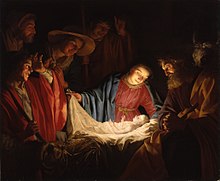Nativity play

A Nativity play or Christmas pageant is a play which recounts the story of the Nativity of Jesus. It is usually performed at Christmas, the feast of the Nativity.
Liturgical
The term "Nativity Drama" is used by Wellesz[1] in his discussion of the troparion hymns in the Christmas liturgy of Byzantine Rite Churches, from Sophronius in the seventh century. Goldstein argues[2] that the label "drama" is misleading, that the troparia are more akin to an oratorio than a play, and that the form is not a precursor of later more decidedly dramatic forms.
Saint Francis of Assisi performed Midnight Mass in the Italian town of Greccio on Christmas Eve 1223 in front of a life-size nativity scene (crib or creche) built by Giovanni Velita, with live animals. This is the first Nativity play.[3] However, more formal Nativity plays have featured in Christian worship since medieval mystery plays.
The 12th to 19th pageants of the 48-play
In modern Germany, the Weihnachten services on Christmas Eve include a children's mass called Weihnachtsgeschichte, which features a Krippenspiel ('crib play').
The German tradition also includes the Erlau Playbook and the plays from Oberufer.
Popular
In
In
In Townsville, Queensland Australia, the Stable on the Strand is an annual nativity play held at the city's oceanfront park.[6][7]
Nativity plays are also popular in the United States. Many larger congregations have an annual play which is popular in the community: one example is the Gift of Christmas, produced annually by Prestonwood Baptist Church at its main campus in Plano, Texas.
It is also very popular in Eastern Europe, notably in Poland and Hungary.
In schools

Many, especially
Literary
Modern writers to have written Nativity plays include
See also
- Passion (death of Jesus) performed at Easter
- Nativity scene - a visual depiction of the Nativity, also known as a crib or creche
- Madrigal dinner — American Christmas musical dinner theater
References
- ^
Wellesz, Egon (1947). "The Nativity Drama of the Byzantine Church". Journal of Roman Studies. 37. Society for the Promotion of Roman Studies: 145–151. S2CID 162243412.
- ^
Goldstein, Leonard (2004). The Origin of Medieval Drama. ISBN 0-8386-4004-4.
- ISBN 978-0-310-87388-4.
- ^ Harris, Cathlyn A. (December 2001). "Los Pastores/Las Pastorelas: Public Theatre, Popular Devotion". Hemispheric Institute, NYU. Archived from the original on 2007-11-28. Retrieved 2008-01-04.
- ^ a b
Gross, Joan (September 2003). Benton Jay Komins (ed.). "Symbolism, Popular Drama, and Politics and Art in Belgium, 1886-1910". Comparative Literature and Culture. 5 (5.3 Comparative Cultural Studies and Popular Culture). ISSN 1481-4374. Retrieved 2008-02-18.
- ^ Fernbach, Nathalie (23 December 2010). "Journey into Bethlehem". ABC (Australia). Retrieved 3 April 2013.
- ^ Fernbach, Nathalie; Calderwood, Kathleen (22 December 2015). "Very first Stable on The Strand baby still supports Townsville event 17 years on". Australian Broadcasting Corporation. Retrieved 10 October 2018.
- ^ The Daily Telegraph - 17 December 2012 - School nativity plays under threat
- ^
Hunt, J. (March 1975). "Moorat". JSTOR 959098.
- ^ https://www.worldcat.org/search?qt=worldcat_org_bks&q=antony+brown+%27%27David+and+the+Donkey%27%27&fq=dt%3Abks [Retrieved 25 November 2020].
- ^ Quinn, Bernard J. (Spring 1972). "The Politics of Despair versus the Politics of Hope: A Look at Bariona, Sartre's First pièce engagée". The French Review (Special Issue, No. 4, Studies on the French Theater): 95–105.
External links
 Media related to Nativity plays at Wikimedia Commons
Media related to Nativity plays at Wikimedia Commons

